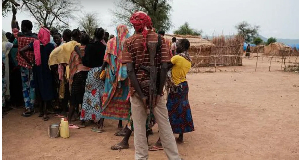Opinions of Monday, 15 March 2010
Columnist: Amponsah, John
Celebrating Akan and Ewe sophisticated traditional weaving technology
By John Amponsah
Kente cloth has become a national symbol of Ghanaians and is worn not only by traditional leaders but also by our political leaders during special occasions. During his inauguration, president Mills had kente cloth as part of his regalia. When William Jefferson Clinton (the then president of America) visited Ghana with his wife Hilary in the late 90’s, both were regaled in kente as a gift from the Ghanaian people. In a more recent example, when the Ghana high commissioner to the UK Prof Boafo Danso was received at Buckingham palace last month, he was wrapped in beautiful kente cloth.
Kente is also popular not only among Ghanaians but among other Africans and even among blacks of the Diaspora. Sometimes even at graduation ceremonies, you see black people having kente as part of their graduation attire.
This article is about some of the intricate designs that can be found in kente cloth. Although both Akan and Ewe have different histories regarding kente, the purpose of this article is not to create further contention and division among Akan and Ewe. Indeed, it is a good occasion to bring us together to celebrate our common heritage.
I read an article recently that showed some very interesting mathematical patterns that are shown in kente cloth. Although the article is primarily about studied Akan patterns, one need not have to stretch their imagination to see identical or similar patterns in Ewe weaving. What interested me most was thinking about how these patterns were woven into the cloth to begin with. Anyone who has seen how traditional weavers go about their work knows that the looms they use are quite intricate. The mere idea of designing passes of thread in specific sequences in order to produce geometric designs is what has fascinated me, and I think sometimes we need to stop to look at and appreciate some aspects of our own heritage.
Another fascinating aspect of the article (below) was the claim that some weaving designs are in a sequence known as the Fibonacci numbers. If this is true, then I think it is very interesting indeed. These Fibonacci numbers and patterns are sometimes found in nature, in plants and in sea shells. Leonardo da Vinci in his art piece called “Vitruvian man” shows proportions of the human body that are in a ratio called the “Golden Ratio”. This golden ratio can also be linked with the Fibonacci numbers.
So if it is true that there are Fibonacci number sequences in some Akan and Ewe weaving patterns, then where did the knowledge of this originate? Did our ancestors come up with the weaving method? The article’s author claims that this knowledge did not come from Europe because at the time the particular weaving patterns he studied (see article) were recorded (in Asante), the population as a whole was not literate in the European way. The author of the article also rules out Arabic influence. So could it be that our ancestors really came up with Fibonacci patterns in their weaving, and if so, where did they get their inspiration from?
I thought the article was a good read because I still remember my mathematics. I think articles such as this one should from time to time bring black Africans together to celebrate particular aspects of our heritage, rather than introducing more division.
Source: www.theakan.com/Akan_Mathematics.html














